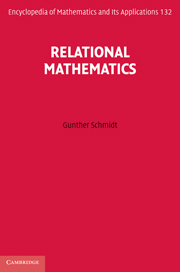Book contents
- Frontmatter
- Contents
- Notes on illustrations
- Preface
- 1 Introduction
- PART I REPRESENTATIONS OF RELATIONS
- PART II OPERATIONS AND CONSTRUCTIONS
- 4 Algebraic operations on relations
- 5 Order and function: the standard view
- 6 Relations and vectors
- 7 Domain construction
- PART III ALGEBRA
- PART IV APPLICATIONS
- PART V ADVANCED TOPICS
- Appendix A Notation
- Appendix B Proofs postponed from Part II
- Appendix C Algebraic visualization
- Appendix D Historical annotations
- References
- Symbols
- Index
4 - Algebraic operations on relations
from PART II - OPERATIONS AND CONSTRUCTIONS
Published online by Cambridge University Press: 05 May 2013
- Frontmatter
- Contents
- Notes on illustrations
- Preface
- 1 Introduction
- PART I REPRESENTATIONS OF RELATIONS
- PART II OPERATIONS AND CONSTRUCTIONS
- 4 Algebraic operations on relations
- 5 Order and function: the standard view
- 6 Relations and vectors
- 7 Domain construction
- PART III ALGEBRA
- PART IV APPLICATIONS
- PART V ADVANCED TOPICS
- Appendix A Notation
- Appendix B Proofs postponed from Part II
- Appendix C Algebraic visualization
- Appendix D Historical annotations
- References
- Symbols
- Index
Summary
A full account of relation algebra cannot be given here, just enough to enable us to work with it. This will be accompanied by examples showing the effects. When relations are studied in practice, they are conceived as subsets R ⊆ X × Y of the Cartesian product of the two sets X, Y between which they are defined to hold. Already in Chapter 3, we have given enough examples of relations between sets together with a diversity of ways to represent them. We will now present the operations on relations in a way that is both algebraically sound and suficiently underpinned with examples.
With this algebraic approach we start in full contrast to such texts as, for example, [125], where relations are also presented in extensu. There, however, everything is based on point-wise reasoning.
Typing relations
In many cases, we are interested in solving just one problem. More often, however, we want to find out how a whole class of problems may be solved. While in the first case, we may use the given objects directly, we must work with constants and variables for relations in the latter case. These variables will be instantiated when the concrete problem is presented.
Let us consider timetabling as an example. It may be the case that a timetable has to be constructed at a given school. However, it would not be wise to write a timetabling program just for this school with the present set of teachers and classrooms. If it is intended to sell the program several times so that it may be applied also to other schools, one must allow for the possibility of different sets of teachers, different sets of classrooms, etc.
- Type
- Chapter
- Information
- Relational Mathematics , pp. 35 - 48Publisher: Cambridge University PressPrint publication year: 2010



